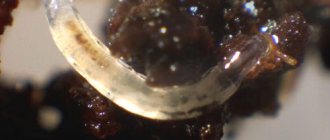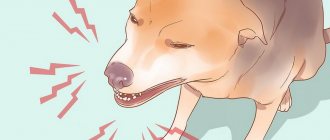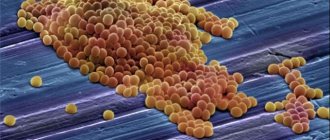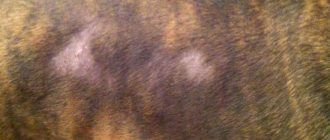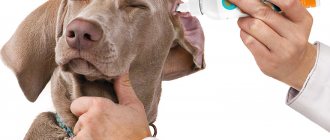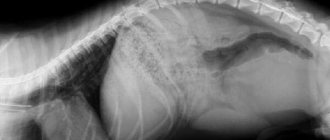Symptoms of tracheitis Diagnosis Treatment
Tracheitis is an inflammation of the mucous membrane of the trachea.
The trachea serves as a “conducting pipe” for air, connecting the larynx and bronchi. The entire mass of air entering and leaving the lungs passes through it. The total lumen of the bronchi is much larger than the lumen of the trachea, therefore all diseases accompanied by a narrowing of the lumen of the trachea (including inflammatory swelling of the mucous membrane or accumulation of sputum) significantly disrupt the breathing process.
The causes of tracheitis may be:
- viruses that cause kennel cough, canine distemper virus;
- bacteria: Bordetella bronchiseptica, Pseydomonas, Mycoplasma, Pasteurella, etc.;
- smoke, dust, irritants contained in the inhaled air;
- parasites (Capillaria aerophila, Oslerus osleri, etc.);
- injuries (strong tug of the leash, blow to the trachea, wounds, rarely foreign bodies).
What is tracheitis and why is it dangerous?
The trachea in dogs is represented by a hollow cylindrical tube consisting of cartilaginous rings and an elastic connective tissue membrane. The organ of the upper respiratory tract connects the larynx and bronchi of the animal. The inside of the trachea is lined with a mucous membrane represented by ciliated epithelium, the main function of which is to moisturize the respiratory organ, conduct and warm air.
In addition, the cells of the inner lining of the trachea perform a protective function, fixing and removing irritants of various natures with mucus: dust particles, viruses, pathogenic microflora. Thus, a healthy body prevents pathogenic infections and foreign bodies from entering the bronchi and lungs.
Tracheitis is an inflammatory process of the mucous membrane of the trachea of an animal. Most often, the disease develops against the background of acute respiratory viral infection or occurs simultaneously with other pathologies of the respiratory system: rhinitis, laryngitis, pharyngitis or bronchitis.
Sometimes the cause of tracheitis is mechanical factors, toxins or an allergic reaction. Pathology of the upper respiratory tract is accompanied by severe swelling of the mucous membrane, increased mucus secretion and the occurrence of a painful reflex cough aimed at clearing the lumen of the respiratory organ.
The development of the disease can go in different ways; the prognosis for tracheitis depends on the causes of the disease, the physiological state of the dog and the neglect of the pathology.
Tracheitis can occur with minimal inflammatory reaction of the mucous membrane, cough and sputum discharge. When pathogenic microflora penetrates the lower respiratory tract, tracheobronchitis, bronchitis or bronchopneumonia develops. The prognosis for pathologies can range from questionable to unfavorable. Sometimes ingestion of sputum with pyogenic microflora by animals leads to the occurrence of inflammatory diseases of the gastrointestinal tract. Severe tracheitis can occur with necrotic processes in the mucous membrane and cartilaginous rings, which lead to the death of the dog from suffocation.
Etiology of tracheobronchitis
The causative agent of infectious tracheobronchitis in dogs is adenoviruses type 1-2 (CAV-1 and CAV-2). The most common pathogens of this disease are: parainfluenza virus, canine reovirus, Bordtella bronchoseptica, and less commonly, herpesvirus.
The bacterium infects the tissues of the respiratory tract, and it can also be found in the upper gastrointestinal tract. After entering the dog’s body, the virus penetrates the cellular structures of the epithelial tissue, attaches to the cilia of the respiratory tract epithelium, which in turn interferes with normal hydration and natural tissue cleansing processes.
The infection is transmitted by airborne droplets, through close contact of a healthy animal with an infected individual, a latent virus carrier.
The main cause of the development of infectious tracheobronchitis in dogs is viral, infectious specific diseases, including those of the respiratory tract. Infectious tracheobronchitis in dogs can be a complicated form of parainfluenza. The disease can develop against the background of secondary diseases, with a decrease in the protective immune mechanisms in the body, as well as in dogs as a result of injuries to the upper respiratory tract, in animals with an abnormal anatomical structure, or congenital anomalies of the respiratory system.
It is possible that a dog may develop tracheobronchitis after suffering severe stress that weakens the animal’s body.
Of the secondary infections that can cause the development of tracheobronchitis, the following can be noted:
- parainfluenza;
- viral rhinotracheitis;
- adenovirus infection;
- mycoplasmosis;
- carnivore plague.
The risk group includes weakened animals, dogs kept in unfavorable conditions (poor hygiene, ventilation, overcrowding of enclosures) when kept in groups in nurseries and enclosures. A pet can catch the infection during transportation, at exhibitions, sports competitions, in general dog walking areas, or through contact with homeless or stray animals.
A contact method of infection of dogs with trachobronchitis, through household items and ammunition, is not excluded.
Provoking factors
The cause of tracheitis in dogs can be various provoking factors of an infectious and non-infectious nature. Sometimes the development of the disease is simultaneously promoted by a number of irritants; in this case, mixed tracheitis is diagnosed, treatment for which is aimed at eliminating all causes of the pathology.
Adverse environmental factors
The following environmental factors contribute to the development of tracheitis in dogs:
- Dust, smoke , excessively dry indoor air and elevated air temperatures.
- Inhalation of excessively cold or hot air by animals leads to vasospasm, a decrease in the protective functions of the tracheal mucosa and the development of an inflammatory process.
- Chemical burns of the trachea caused by animal inhalation of fumes from household chemicals, paints and varnishes and chemical reagents.
- , which release huge amounts of poisons into the environment, often get sick
Infectious causes
Infectious tracheitis in dogs can be bacterial, viral, parasitic and fungal.
- Diseases of a viral nature are caused by influenza, parainfluenza, herpes, plague viruses, as well as adenoviruses and reoviruses. Viral tracheitis is a deadly disease for unvaccinated small puppies who have not yet developed immunity.
- Bacterial diseases are caused by pathogens of mycoplasmosis, bordetellosis, pasteurellosis, and pseudomonosis. Infectious tracheitis is characterized by an acute course, fever and the addition of a secondary infection.
- The causes of inflammation of the trachea of parasitic etiology are the defeat of the dog by helminths migrating through the respiratory tract during their development cycles.
Complications of colds
Frequent colds can cause complications, manifested in the occurrence of pathologies of the respiratory system: tracheitis, pharyngitis, rhinitis, bronchitis and pneumonia.
An unbalanced diet, keeping a pet in a cold, damp room, frequent drafts, long walks in damp, cold weather are the causes of colds and a decrease in the body's defenses.
The cause of tracheitis can be feeding the dog frozen meat, drinking cold water, or, conversely, feeding excessively hot food, leading to a sharp narrowing or expansion of the lumen of the tracheal vessels, a decrease in local immunity and the occurrence of an inflammatory reaction.
Mechanical factors
Mechanical causes of tracheitis in dogs include:
- Damage to the integrity of the cartilaginous rings as a result of bites and injuries, unprofessional intubation or operations.
- Narrowing of the tracheal lumen can be caused by a growing tumor, foreign body entry, stenosis or hyperplasia of the respiratory organ.
- Compression and damage to the trachea occurs when the dog is treated roughly during training, training, or when the collar size is incorrectly selected.
Allergic reaction
Dogs that are hypersensitive to certain allergens may develop allergic tracheitis in response to various irritants. The pathology manifests itself in the form of bronchospasm and reflex cough, often leading to obstructive bronchitis and pulmonary edema.
An allergic reaction can occur when inhaling dust mites, plant pollen, mold spores, or household chemicals. The presence of antibodies to external allergens in the blood of animals is often inherited or fixed at the genetic level in some dog breeds.
Etiological factors
Firstly, the herpes virus may be to blame for the disease. The same applies if a dog is infected with mycoplasma, chlamydia or bordetella. The peculiarity of all these pathogens is that they have a “predisposition” to damage the organs of the upper respiratory tract. Sometimes tracheitis can be caused by pathogenic fungi, and this is the most difficult and unpleasant option, since this type of infection is difficult to treat, and the diagnosis here is quite difficult.
If we talk about non-infectious factors of the inflammatory process, then we should mention the increased air temperature in the room, its dryness and/or dustiness. Tracheitis quite often affects dogs living near large chemical and construction enterprises, where a large volume of fine dust is constantly present in the air. However, in this case, you won’t envy the dog’s owners, since they themselves know firsthand about respiratory diseases. Finally, don't discount the possibility of a bad cold. This is especially true for small, smooth-haired dogs whose owners have walked them too long in the cold and slush.
Forms of tracheitis in dogs
Along the way, there are two forms of tracheitis in dogs: acute and chronic. Pathologies differ in their causes and clinical picture.
Acute form
Acute tracheitis is characterized by high fever, a dry cough turning into a wet one, and the presence of associated symptoms: sneezing, nasal discharge, refusal to feed. Most often, the cause of acute inflammation of the trachea in dogs is an infection of a bacterial, viral, fungal or parasitic nature.
Acute tracheitis develops from trauma to the trachea, inhalation of chemicals, cold or hot air. Often, an acute form of pathology occurs with a cold against the background of inflammation of the upper and lower respiratory tract.
Chronic form
Chronic tracheitis is a complication of the acute form of the disease or a consequence of prolonged exposure to adverse environmental factors: dusty, smoky premises, polluted air.
The chronic form of the pathology occurs when the trachea is compressed by a growing tumor, hypertrophy of the respiratory organ, parasitic infestations, diseases of the lungs, heart and kidneys. Chronic tracheitis is characterized by attacks of painful dry or wet cough and progressive exhaustion of the animal.
Symptoms of the disease
The main clinical signs of this disease are uncontrollable attacks of dry and convulsive cough, profuse nasal discharge, inflammation of the tonsils (it is this symptom that often leads dog owners to the erroneous assumption that the dog has a sore throat). Appetite with infectious tracheobronchitis remains the same. In general, a pet's appearance and behavior may in no way indicate illness. At the initial stage of development of tracheobronchitis, the temperature can rise to 39 degrees Celsius or more. One should also take into account the fact that the disease itself can occur in acute and subacute forms.
If your dog has an acute form of infectious bronchitis, the above symptoms will develop very quickly. In addition to them, the animal may develop diseases such as rhinitis, bronchitis and tracheitis. Typically, this form of the disease is characterized by a short period of progression. As a rule, recovery occurs 1-2 weeks after infection. If the dog has a weak immune system or has secondary infections, complications such as pneumonia, bronchopneumonia, or laryngotracheobronchitis may occur. If such problems are discovered, you should take it very seriously - such complications can lead to serious health problems for the animal and even death.
The subacute form of tracheobronchitis in dogs is characterized by a longer course (2-4 weeks). In general, the symptoms of the disease are identical to the general clinical signs of tracheobronchitis, but may be less pronounced. Depending on the individual characteristics of the pet’s body, the dog may experience various gastrointestinal disorders, for example, diarrhea or vomiting.
To make a correct diagnosis, specialists first of all need to exclude all possible non-infectious causes of a severe dry cough. It should also be taken into account that it is often impossible to clinically determine the type of causative agent of the disease. That is why, in the diagnostic process, doctors usually use medical history, a list of vaccinations, and hematological studies.
At an early stage of the disease, a noticeable decrease in the number of leukocytes in the blood is detected. This negative dynamics is typical for viral tracheobronchitis. If doctors find neutrophilic leukocytosis (with a shift to the left), most likely the animal has pneumonia.
With tracheobronchitis, blood and urine tests are usually completely normal.
Some doctors insist on using an x-ray procedure. Even though it does not help detect characteristic signs, such a study can exclude potential non-infectious causes of a dry cough in a dog.
In severe stages of the disease, doctors recommend bronchoscopy, which will allow fluid to be taken from the trachea and then carried out a bacteriological examination. This procedure can help determine the degree of sensitivity of microflora to various types of antibiotics.
Primary and secondary tracheitis
Depending on the origin there are:
- Primary tracheitis is extremely rare in dogs; it develops independently in the form of local inflammation of the tracheal mucosa.
- Secondary tracheitis occurs simultaneously with other diseases of the respiratory system. If the mucous membrane of the nose, pharynx and trachea are involved in the pathological process, we are talking about rhinopharyngotracheitis.
- With simultaneous damage to the larynx and trachea in dogs, laryngotracheitis is diagnosed; inflammation of the mucous membrane of the trachea and bronchi is called tracheobronchitis. The clinical picture of the disease has mixed symptoms, so only an experienced specialist should diagnose the disease.
Symptoms and diagnosis in a veterinary clinic
The main symptom that characterizes the development of tracheitis is cough. As a rule, the cough is unusually strong, hysterical, and dry. It weakens the pet. The animal looks lethargic, apathetic, sleeps a lot and moves little.
With inflammation, the body temperature rises, and the characteristic sounds of hissing or wheezing can be clearly heard when breathing. The dog refuses food, and there are disturbances in the breathing process (shortness of breath).
Tracheitis exhausts the pet, so most of the time it lies down, refusing to respond to the owner’s calls. In some cases, the animal is irritated and may even show aggression so as not to be bothered.
Symptoms of the pathology increase rapidly, so at the first sign of ill health, it is necessary to take the dog to a qualified veterinarian. Trying to cure tracheitis on your own without knowing the nature of its origin is not only pointless, but also quite dangerous.
The cause of inflammation of the tracheal mucosa can be fungal microorganisms and antimicrobial agents will not have the desired effect.
Taking antibiotics in this case will become a kind of springboard for the development of complications. If the origin of tracheitis is viral, taking antibiotics is also useless.
That is why, when visiting a veterinary clinic, the doctor prescribes a series of laboratory tests and takes a scraping from the throat to identify the causative agent of inflammation. To make a diagnosis, it is necessary to take blood for analysis and conduct an X-ray or ultrasound examination of the sternum. This will make it possible to determine the degree of neglect of the pathological process.
Symptoms and first signs of the disease
Tracheitis causes severe discomfort to a sick animal and is fraught with the development of complications, therefore, when the first signs of the disease are detected, it is recommended to consult a specialist.
When the trachea is inflamed, an animal exhibits the following characteristic symptoms:
- a rough, painful, dry cough that turns into a wet cough when sputum is expelled;
- bouts of severe coughing are accompanied by pain and vomiting;
- increase in body temperature up to 39C;
- lethargy, weakness, increased fatigue;
- refusal of food;
- progressive exhaustion;
- dyspnea;
- heavy breathing, sometimes with wheezing and whistling;
- loss of voice, hoarse barking;
- sneezing, discharge from the nose and eyes.
Main symptoms
The first and most noticeable symptom of tracheitis is a cough. It is usually strong, dry and hysterical, very weakening the dog. A sick animal becomes lethargic, sleepy and inactive. His body temperature rises, wheezing and hissing when breathing, shortness of breath, and loss of appetite.
The dog mostly lies down without reacting to people, but can sometimes show signs of irritation and even aggression if he is bored.
Can a person get tracheitis from a dog?
If tracheitis is caused by non-contagious causes, then contact with a sick animal is not dangerous for humans. Here we are talking about pathology caused by allergic, thermal, chemical and unfavorable environmental factors.
Infectious tracheitis can be contagious to the host if it is caused by respiratory viruses or influenza pathogens. In this case, when feeding, treating and caring for a sick pet, it is necessary to observe preventive measures.
How can you help an animal?
If you notice any warning signs, you should seek help from a qualified veterinarian. The diagnosis is made based on examination. If necessary, an x-ray is prescribed. If the dog cannot breathe, a hole is made in the trachea. After this, the specialist prescribes treatment.
If your dog is having trouble breathing, take him to the veterinarian.
Advice. You should not begin treating your dog without consulting your veterinarian.
Otherwise, the clinical picture will only worsen. If necessary, a veterinarian should be called to the house.
During the treatment period, the dog is placed in a warm room. It is recommended to limit walking time, especially in the cold season. It is advisable not to walk sick Yorkshire terriers and other small dogs at all.
Drug therapy
If the pathological process is uncomplicated, the dog is prescribed the following:
- antihistamines;
- mucolytic medications;
- antitussive drugs;
- expectorants.
The most effective antihistamine is Diazolin. Of the mucolytics, Mucaltin and Bromhexine help best. Libexin is considered the best antitussive drug. The most effective expectorant drug is Sodium bicarbonate.
In case of complications
If tracheitis is very severe, the veterinarian prescribes the following:
- Nitrofuran derivatives.
- Sulfonamides.
- Antibiotic drugs.
- Antimicrobial drugs.
To treat tracheitis, antibiotics, sulfonamides and other drugs are used.
When prescribing these medications, the veterinarian undertakes to identify contraindications and take them into account.
At the same time, it is recommended to use multivitamin and vitamin preparations (Gamavit, Glycopin, etc.).
Nonspecific resistance of the canine body can be increased by introducing nonspecific or specific serum.
In case of chronicity
If a dog is diagnosed with chronic tracheitis, the doctor undertakes to identify the causative agent. Often the chronic form of this pathology progresses against the background of helminthiasis. If the animal is affected by worms, it is recommended to remove them first. After this, the veterinarian begins treatment of chronic tracheitis.
If the root cause of chronic tracheitis is a neoplasm, then only surgical intervention can help.
Diagnosis of the disease
Diagnosis of the disease is carried out in a veterinary clinic using general and additional research methods. Urgently exclude the possibility of an infectious disease, intoxication, tracheal injury, foreign body entry or compression of an organ by a growing tumor. Differential diagnosis is necessary for urgent prescription of therapeutic measures and saving the life of the animal.
To confirm the diagnosis, an examination of the dog, laboratory testing of urine and blood tests, and an x-ray of the animal’s chest are performed. X-rays of the animal are performed in the anterior and lateral projections; with the help of images, you can check the integrity of the trachea, exclude or confirm the presence of foreign objects in the respiratory organ, and distinguish tracheitis from pneumonia. Additional research methods include auscultation and tracheobronchoscopy.
Treatment scheme for tracheitis in the clinic
Severe disease of the respiratory system in dogs is carried out in a hospital setting. In the absence of the ability to breathe independently, the animal is intubated - insertion of a tube, or a tracheostomy - an opening in the trachea. To relieve intoxication, drip infusion of electrolytic solutions is used.
Treatment regimen for tracheitis in dogs in a veterinary clinic:
- eliminating the cause of the disease with the help of antibacterial, antiviral, antifungal agents if the disease is infectious in nature;
- symptomatic therapy: use of expectorants, antitussives, antipyretics, antiallergic drugs;
- stimulating the body's defenses by prescribing vitamins and immunostimulants.
Important! The prescription of medications is carried out after a bacteriological examination of sputum to determine the sensitivity of the pathogen to the drugs.
Treatment method and prognosis
Treatment is always related to the underlying cause of the disease. For a bacterial infection, antibiotics are prescribed, for fungi, antifungal therapy, and if a virus is detected, antiviral therapy. For combined infections (fungi + bacteria or viruses + bacteria), antibiotics are added to the list of medications.
It is very important to quickly relieve the symptoms of intoxication, which with tracheitis increase very quickly. For this purpose, the dog may be left in the clinic for several days for a course of IV drips. The animal is also prescribed drugs to maintain the activity of the lungs and heart, drugs to reduce the risk of pulmonary edema, antitussives, restorative drugs and vitamins.
If you contact the clinic early, it is possible to quickly eliminate the signs of infection, and the dog recovers. If tracheitis has complications, treatment can be lengthy and complex.
Tracheitis caused by the herpes virus never goes away without a trace, since this virus cannot be destroyed or removed from the body. Under suitable conditions, relapses are possible.
Treating a dog at home
If the inflammatory disease of the trachea is mild or after the symptoms of intoxication have resolved, the dog can be treated at home under the supervision of a veterinarian.
- The animal must be kept in a warm, dry room that prevents drafts.
- To improve sputum discharge, dogs can be given solutions of medicinal herbs that have an expectorant and anti-inflammatory effect.
- In the absence of fever, heating and warming compresses are indicated.
- The room where a sick pet is kept must be wet cleaned daily.
- During the period of illness, it is advisable to exclude contact of the four-legged patient with young and elderly family members to avoid infection.
- Long walks are excluded; if possible, it is better to limit walking of the animal until complete recovery.
How is bronchitis treated in a dog?
Treatment of bronchitis is often carried out at home, so there is no need to place the dog in a hospital. Therapy is aimed at eliminating the symptoms and causes of the disease. For this purpose, veterinarians prescribe various medications:
- Expectorants and antispasmodics . They eliminate spasms, and also dilute and accelerate the removal of mucus from the respiratory tract, alleviating the animal’s condition;
- Anthelmintics . They are prescribed if bronchitis is caused by parasitic diseases. Such drugs are effectively used for the treatment and prevention of helminthiasis;
- Bronchodilators . They relax the muscles of the bronchi, thereby expanding the airways. Drugs in this group are common in the form of aerosols, so they are convenient to use;
- Antihistamines and glucocorticosteroids . Help with allergic reactions and also prevent their occurrence;
- Other medicines . These include cardiac glycosides (improve and restore the functions of the cardiovascular system), mucolytics (thin sputum), and antibiotics (fight bacterial infections).
All medications for the treatment of bronchitis in dogs must be taken strictly as prescribed by a veterinarian!
Physiotherapy
In complex therapy of bronchitis, dogs are often prescribed physiotherapeutic procedures. These include heating with an infrared lamp, ultra-high-frequency therapy (exposure to the animal’s body with a high-frequency electromagnetic field), as well as diathermy (electrotherapy). Each of these procedures facilitates the removal of sputum, restores the pet’s body and strengthens its immune system.
On a note! Additionally, the dog may be prescribed inhalations. They stop coughing and prevent new attacks.
List of drugs and antibiotics
In each specific case, different drugs and dosages are prescribed; if there is no positive dynamics within 3-5 days, the doctor may replace the medicine with a stronger analogue.
List of medications and antibiotics for the treatment of tracheitis in dogs:
- antibacterial drugs - Baytril, Tsiprovet, Ceftriaxone, Amoxicillin, Marfloxin;
- antiviral agents – Neotime, Neoferon, Camedon, Anandin, Fosprenil, Dostim;
- antitussive and expectorant medications - Terpinhydrate, Bronchipret, Butamira, Mucaltin.
In addition to synthetic drugs, the animal is recommended to drink a warm decoction of chamomile or rose hips; often, a breast milk is prescribed to improve the removal of sputum.
Important! Any medications should be prescribed by a veterinary specialist, taking into account the advanced stage of the disease and the physiological state of the animal.
Therapy
You cannot begin treatment without determining the exact cause and/or causative agent of the disease! If you treat a dog suffering from fungal tracheitis with conventional antibiotics, you will not see any improvement, but you may lose the dog. So the veterinarian will first take blood tests and scrapings from the larynx. Treatment of tracheitis in a dog directly depends on the cause of the inflammation. For infectious pathologies, antibiotics are administered; if the disease is viral in nature, I use them, but with the aim of preventing the development of secondary infections. Thus, treatment methods often involve symptomatic therapy.
Vitamin preparations and drip administration of solutions that relieve intoxication are used. Agents are administered to eliminate swelling of the mucous membranes (steroid-based), as well as medications to maintain respiratory and cardiac activity. It is important to note that when a dog is infected with the herpes virus, a 100% cure never occurs, and the pathogen always remains in the body. It can manifest itself under any stress or some kind of cold infection, so the owners of such dogs always have to remain on guard.
Feeding a sick dog
Feeding a sick dog involves using pureed soft food in the animal’s diet:
- Food should be fresh, warm and moderately thick.
- The dog can be fed with grated boiled vegetables, boiled cereals, soups, soft cottage cheese, diluted kefir or unsweetened yogurt.
- In the evening, you can treat your four-legged patient to twisted boiled chicken, turkey or beef.
- If possible, the diet includes finely chopped fresh herbs and vegetable oil.
- In case of complete refusal of food, intravenous infusion of electrolyte solutions with glucose is indicated.
Feeding a dog when sick
When your dog is sick, it is best to avoid dry food.
During the period of illness, it is advisable to include easily digestible warm food in the dog’s diet. Porridge (rice, oatmeal), boiled and pureed meat (chicken, beef), heated dairy products (kefir, milk) are suitable. Raw eggs can be given one at a time no more than three times a day. It is better to refuse dry food until the dog’s cough goes away.
A sick dog should have a bowl of water at room temperature. You can add to the water decoctions of herbs with an expectorant effect (anise, dill, pine buds, oregano, wild rosemary) or anti-inflammatory (chamomile, sage, eucalyptus, string, yarrow). Rice water is also suitable for drinking.
Respiratory diseases occur due to a deficiency of vitamins A, E and C, so it is worth introducing foods rich in these vitamins into the diet, or purchasing a vitamin-mineral complex for animals.
If your pet coughs, this is a reason to immediately show it to a veterinarian. If treatment is started promptly, your dog's bronchitis will go away within one or two weeks. Otherwise, a chronic form of the disease may develop, and this is dangerous for the cardiovascular and nervous system of the animal.
The inflammatory process occurring in the tracheal mucosa is called tracheitis. The main reason for the development of pathology is improper maintenance of dogs.
Prevention measures
The occurrence of tracheitis in a dog can be avoided by following simple preventive measures:
- annual preventive vaccination of dogs according to the vaccination schedule;
- avoiding contact with stray dogs and cats, which are sources of infections;
- keeping your pet in a warm, dry room;
- avoiding long walks in damp and frosty weather;
- balanced feeding using vitamin and mineral supplements;
- annual preventive examination by a veterinarian with laboratory testing of urine and blood tests.
Advice! Temper your dog with soy, feed it properly, walk in the fresh air, then infectious and cold diseases will bypass it.

